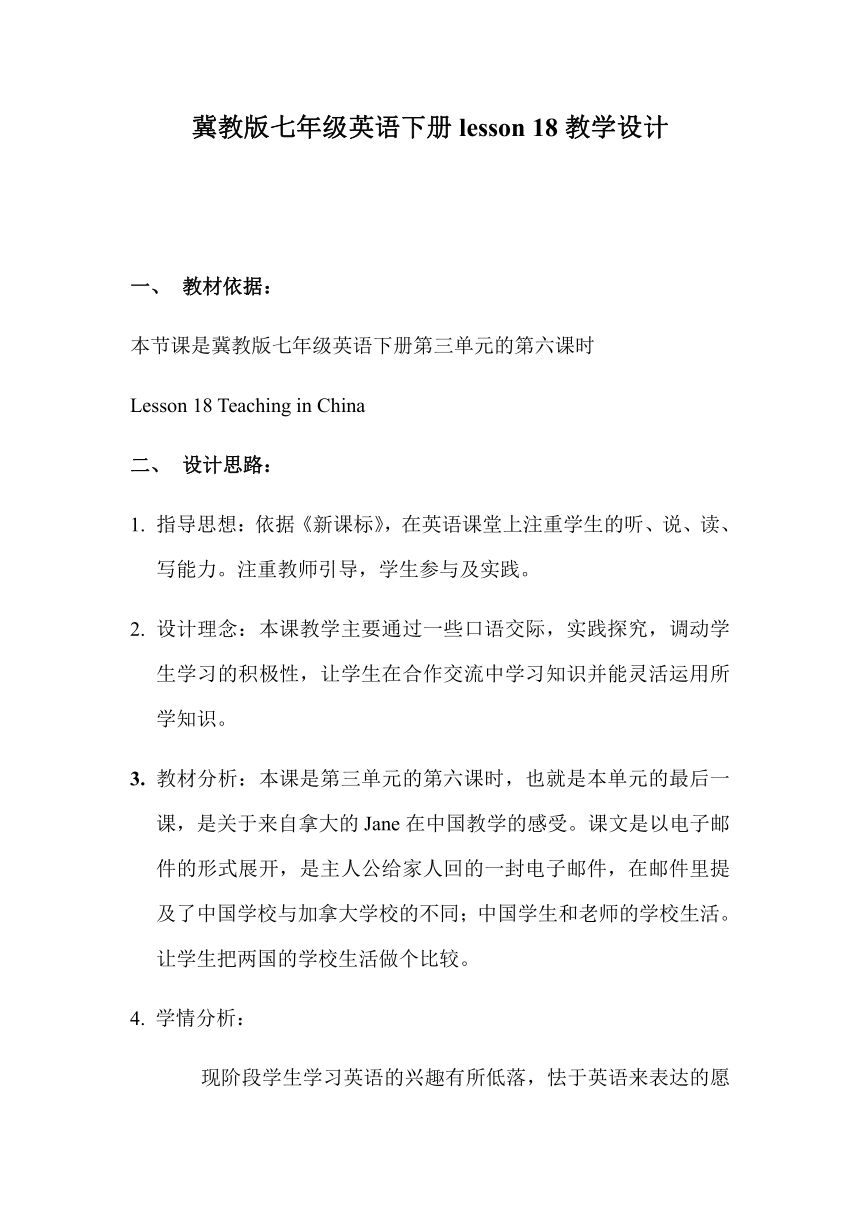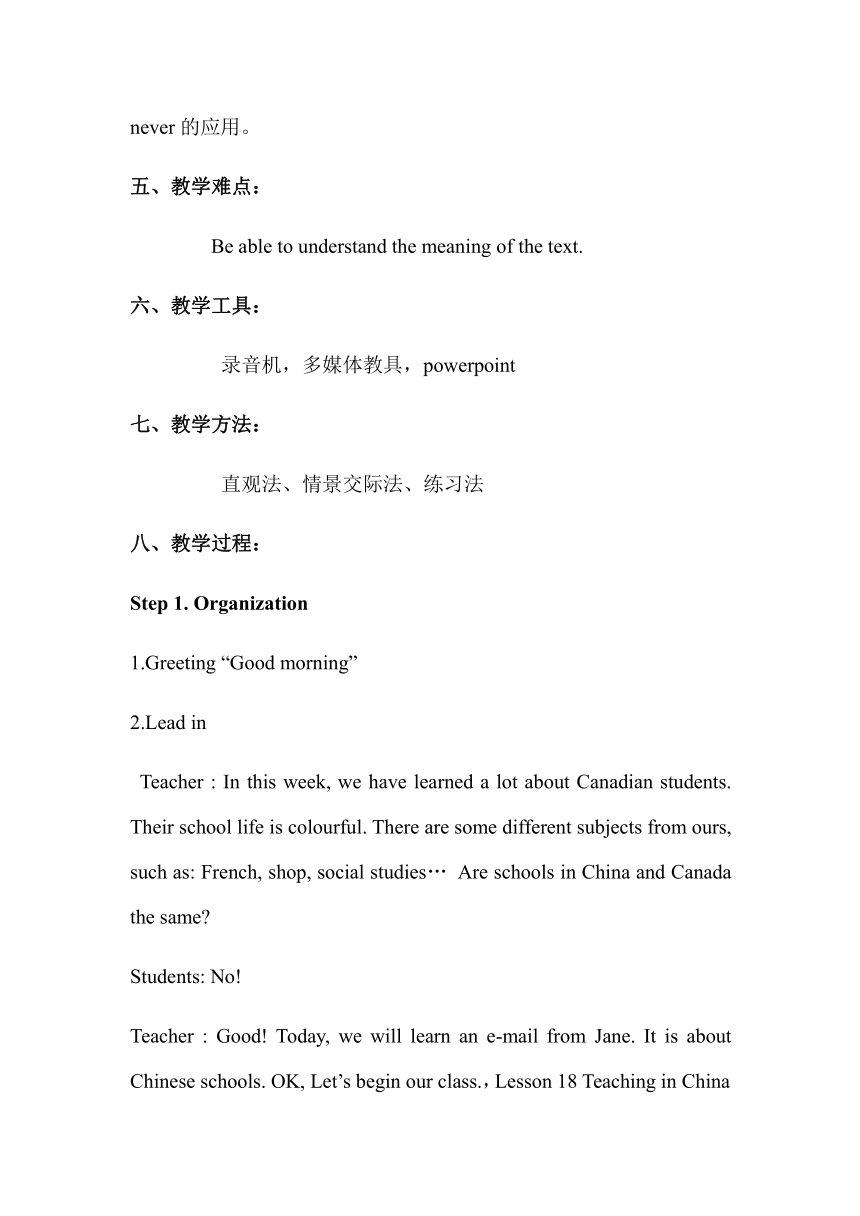冀教版英语七年级下册Unit 3:Lesson 18 Teaching in China. 教学设计
文档属性
| 名称 | 冀教版英语七年级下册Unit 3:Lesson 18 Teaching in China. 教学设计 |  | |
| 格式 | zip | ||
| 文件大小 | 30.5KB | ||
| 资源类型 | 教案 | ||
| 版本资源 | 冀教版 | ||
| 科目 | 英语 | ||
| 更新时间 | 2020-05-08 15:04:32 | ||
图片预览



文档简介
冀教版七年级英语下册lesson 18教学设计
1、 教材依据:
本节课是冀教版七年级英语下册第三单元的第六课时
Lesson 18 Teaching in China
2、 设计思路:
1. 指导思想:依据《新课标》,在英语课堂上注重学生的听、说、读、写能力。注重教师引导,学生参与及实践。
2. 设计理念:本课教学主要通过一些口语交际,实践探究,调动学生学习的积极性,让学生在合作交流中学习知识并能灵活运用所学知识。
3. 教材分析:本课是第三单元的第六课时,也就是本单元的最后一课,是关于来自拿大的Jane在中国教学的感受。课文是以电子邮件的形式展开,是主人公给家人回的一封电子邮件,在邮件里提及了中国学校与加拿大学校的不同;中国学生和老师的学校生活。让学生把两国的学校生活做个比较。
4. 学情分析:
现阶段学生学习英语的兴趣有所低落,怯于英语来表达的愿望,且又害怕说错,因而,要鼓励他们大胆发言,让他们享受到英语学习带给他们的快乐,提高学习兴趣。因为英语学习刚起步,很多时候要在老师的引导下才能完成。这课是学生对本单元内容的一个总结和提升,重点是考察学生对英语短文的理解能力。对学生来说,有些难度。
3、 教学目标:
知识目标:
掌握词汇及短语:teach , quite, nervous, comfortable, helpful ,move from…to…
接触的词汇:relaxed,
能力目标:
1. 能了解课文大意。
2. 能通过课文区分出加拿大学校与中国学校的不同。
3. 能用英语做类似的情景对话。
情感态度与价值观:
培养学生学习英语的兴趣和好的学习习惯; 教育学生们热爱祖国
四、教学重点:
单词的灵活运用,频度副词always, often, usually, sometimes, never的应用。
五、教学难点:
Be able to understand the meaning of the text.
六、教学工具:
录音机,多媒体教具,powerpoint
七、教学方法:
直观法、情景交际法、练习法
八、教学过程:
Step 1. Organization
1.Greeting “Good morning”
2.Lead in
Teacher : In this week, we have learned a lot about Canadian students. Their school life is colourful. There are some different subjects from ours, such as: French, shop, social studies… Are schools in China and Canada the same?
Students: No!
Teacher : Good! Today, we will learn an e-mail from Jane. It is about Chinese schools. OK, Let’s begin our class.,Lesson 18 Teaching in China
Step2. New words
1. Present some pictures to learn new words.(图片展示表示感觉的词汇,直观、生动、形象)
2. Read the new words after the teacher.
3. use these words to fill in the blanks.(实践练习)
nervous friendly relaxed wonderful teach
1. I don't know anyone at the party. But everyone was very ________.
2. Spring is nice and warm. It is a _______ season.
3. Li Ming is going to give a talk. He is quite _______.
4. I'm a teacher. I _____ music at a middle school.
5. After a busy day, I like to sit and drink a cup of tea. It makes me feel________.
Step 3 Listen (放两遍录音,让学生能够正确判断信息)
Listen to the tape and write true (T) or false (F).
1. Jane arrived in China last week. ( )
2. Everyone is friendly and nice to Jane. ( )
3. Canadian students don't move to different classrooms for their classes. ( )
4. Jane 's students teach her about their culture. ( )
Step4. Read the lesson.(自读,领读,跟读)
1. Read the lesson by the students themselves.
2.Read the lesson after the audiotape.
3. Read the lesson after the teacher.
4. List some differences between Chinese and Canadian schools.
China
Canada
Step 5 Work in groups. Interview your classmates and fill in the table.
Name Do your homework homeworkhomework Help out at home Walk to school Play sports
Li Ming ▲ ▇ ● ★
▲ always ★ often ● usually ▇ sometimes ▍never
After finished , let students make up a dialogue according to this table.
Example:
A: Li Ming, do you do your homework ?
B: Yes. I always do my homework.
A: Do you help out at home?
B: Yes. I sometimes wash the dishes.
Step 6. Summary
Today, we have known about Jane’s school life in China. We also knew about some differences between Chinese and Canadian schools. We all come from China. Our country has a long history and rich culture. And the Great Wall in China is very famous. Do you know a Chinese saying:
A man who has not climbed the Great Wall is not a true man?
Do you know the meaning of this sentences in Chinese ?
Step 7. Homework
1. remember the words and phrases in this lesson
2. read the passage fluently
3. write a short passage about Chinese school life
教学反思:
这节课通过概括本单元前面的内容引导学生自学课文,了解课文大意。学生的学习积极性被调动了起来,对于所巩固知识的题目做的很快。课文内容贴近生活,学起来也较快,大多数学生都能掌握所学单词和短语,也能够了解课文大意。由于时间紧张,最后一部分的小组合作完成的较为仓促。下课后,让学生多加练习,增强他们的口语表达能力。
同课章节目录
- Unit 1 A Trip to the Silk Road
- Lesson 1 A Trip to China
- Lesson 2 Meet You in Beijing
- Lesson 3 A Visit to Xi'an
- Lesson 4 A Visit to Lanzhou
- Lesson 5 Another Stop along the Silk Road
- Lesson 6 Jenny's Diary
- Unit 2 It's Show Time!
- Lesson 7 What's Your Project about?
- Lesson 8 Marco Polo and the Silk Road
- Lesson 9 Danny's School Project
- Lesson 10 Music and Dance
- Lesson 11 Food in China
- Lesson 12 A Blog about the Silk Road
- Unit 3 School Life
- Lesson 13 How Is School Going?
- Lesson 14 Jenny's School Life
- Lesson 15 Making a Difference
- Lesson 16 We Are with You!
- Lesson 17 School Science Fai
- Lesson 18 Teaching in China
- Unit 4 After-School Activities
- Lesson 19 A Dinner Date
- Lesson 20 Join Our Club!
- Lesson 21 What Is Your Club Type?
- Lesson 22 Big Plans for the Weekend
- Lesson 23 A Weekend with Grandma
- Lesson 24 How was Your Weekend?
- Unit 5 I Love Learning English!
- Lesson 25 A Phone Friend
- Lesson 26 Online Phone Calls
- Lesson 27 Amazing English
- Lesson 28 How Do I Learn English?
- Lesson 29 A Door to the World
- Lesson 30 Writing an E-mail in English
- Unit 6 Seasons
- Lesson 31 What Strange Weather!
- Lesson 32 I Can't Wait for Winter!
- Lesson 33 Kim's Favourite Season
- Lesson 34 Steven's Report
- Lesson 35 Surfing in Sydney
- Lesson 36 Spring in China
- Unit 7 Sports and Good Health
- Lesson 37 You Are What You Eat!
- Lesson 38 Stay Healthy!
- Lesson 39 Danny's Report
- Lesson 40 Move Your Body
- Lesson 41 Were People Healthy Then?
- Lesson 42 Know Yourself
- Unit 8 Summer Holiday Is Coming!
- Lesson 43 Have a Good Summer!
- Lesson 44 Volunteering in Summe
- Lesson 45 Baseball Season
- Lesson 46 Get Ready for Summer Holiday!
- Lesson 47 Summer Plans
- Lesson 48 Li Ming's Summer Holiday
